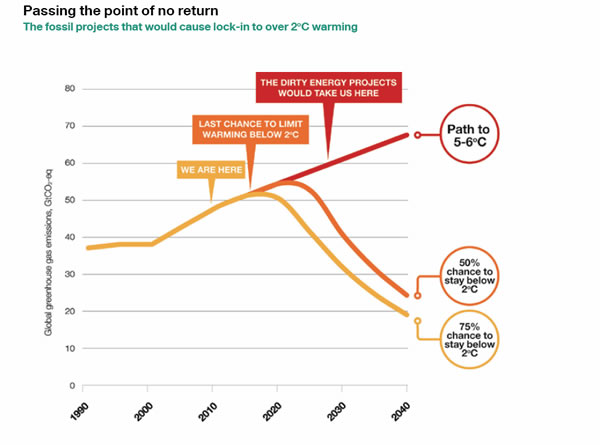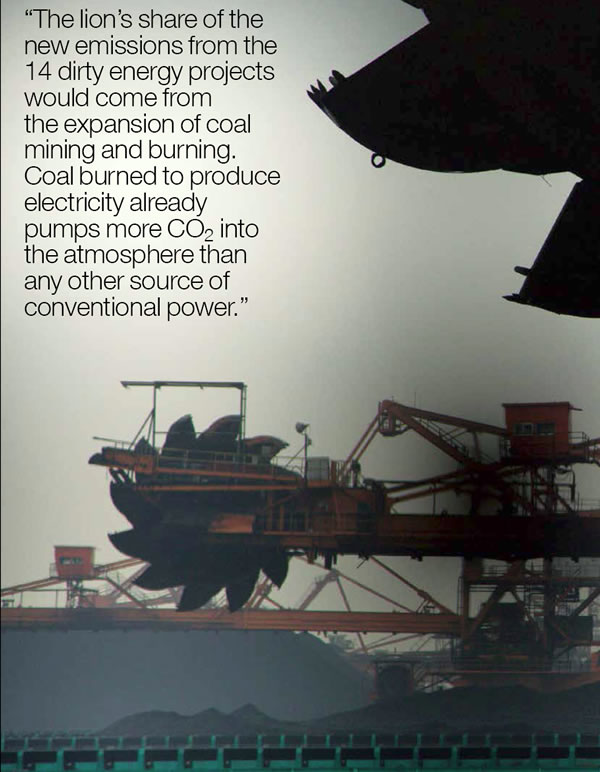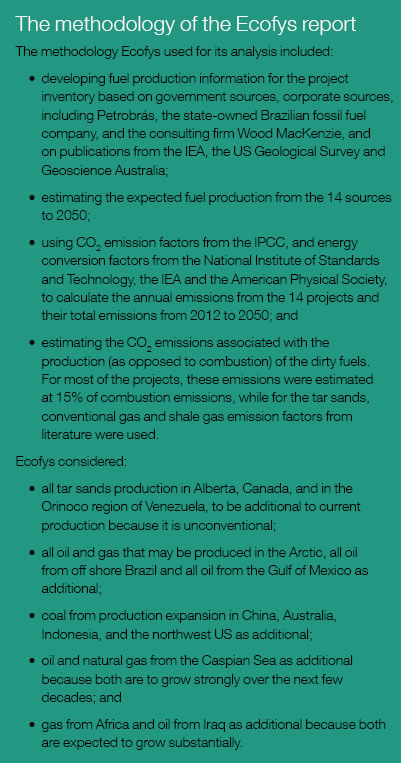|
The supporting research for this report into the impact of the 14 enormous coal, oil and shale gas extraction projects was carried out
by Ecofys, a consulting company well known for its expertise in analysing climate policies and sustainable energy solutions to climate
change. A much-simplified discussion of the Ecofys analysis shows that business-as-usual, including the emissions from the 14 projects,
would see cumulative CO2 emissions of 2,340Gt of CO2 equivalent (Gt CO2e) from 2011 to 2050. This is a clear scenario for climate disaster,
consistent with a 5-6°C increase in average global temperature.
Current, but woefully inadequate, measures to reduce emissions might cut the global temperature rise to approximately 4ºC, still a
“devastating” outcome according to the World Bank.
A carbon budget developed by Ecofys identifies a scenario that shows there is still a 75% chance of keeping the global average temperature
increase below 2ºC. To stay within this carbon budget, cumulative emissions between 2010 and 2050 cannot exceed 1,050Gt CO2e, and
global emissions need to start decreasing at the very latest by 2016.
The problem is that investment in energy infrastructure for fossil fuels locks the world into using coal, oil and gas for decades. The
IEA estimates that 590Gt CO2 is already locked in by existing fossil fuel-dependent infrastructure, and building new coal, oil and gas
based infrastructure must stop by 2017 to avoid locking in more emissions than can be emitted without overshooting 2ºC warming. After
that, the only way to stay below 2ºC warming is to shut down the many new coal, oil and gas power plants and the new coal mines and
oil operations that could be operating, making the task of meeting the target hugely expensive and politically difficult. The 14 energy
projects would ensure that the dirty energy investments continue well beyond that point of no return.
The growth in fossil fuel consumption driven by the 14 massive projects alone would eat up the remaining carbon budget, when existing lock-in
is taken into account: Ecofys calculates the cumulative emissions to 2050 from the 14 projects at 300Gt CO2e. Put differently, replacing
the dirty projects with safe and clean energy would provide almost one third of the reduction needed to have a 75% chance of avoiding climate
chaos.
This 75% chance is still available, even though global carbon emissions reached the record highs the IEA calculated in 2010 and 2011, and
even though emissions have been growing faster in the last two years than in even the most pessimistic scenarios envisaged by the IEA and
the Intergovernmental Panel on Climate Change (IPCC).

The key to avoiding climate chaos is to act immediately to reduce emissions in this decade. Climate scientists calculate that the carbon
that has already accumulated in the atmosphere will likely increase the average temperature by another 0.8ºC. Therefore, the room
to manoeuvre to reduce emissions is getting smaller all the time, given the continued ineffective action of governments.
The IEA has said more than once that there is little room for manoeuvre. In November 2012, when it released its annual World Energy Outlook,
IEA chief economist Fatih Birol said: “The chances are slimmer and slimmer of avoiding a 2°C rise.” The IEA also said that
CO2 emissions related to energy production are expected to increase from “an estimated 31.2Gt in 2011 to 37.0Gt in 2035, pointing
to a long-term average temperature increase of 3.6°C.”
The 75% scenario developed by Ecofys shows that emissions must peak in 2015 and then decline by 5% a year to get cumulative emissions down
to 1,500Gt, the combination of historic emissions of 450Gt CO2e and the Ecofys carbon budget of 1,050. That of course means not adding
the 300Gt of new emissions the 14 projects would create by 2050.
The world should be – but is clearly not – on a path to lower emissions already. Almost 200 nations agreed in 2010 to limit
the global average temperature rise to below 2ºC, to avoid the most devastating impacts from climate change. The new coal, oil and
gas projects featured in this report will make cutting emissions even more difficult.
The lion’s share of the new emissions from the 14 dirty energy projects would come from the expansion of coal mining and burning.
Coal burned to produce electricity already pumps more CO2 into the atmosphere than any other source of conventional power. Coal-fired power
plants are responsible for three-quarters of “locked in” emissions in the power sector. By 2020, the dirty projects would extract
an additional 1,400 million tonnes of coal, enough to fuel 550 large coal-fired power stations. The growth in coal use is the sole reason
CO2 emissions grew at record rates over the past two years. Coal burning also produces pollutants and toxic emissions that cause hundreds
of thousands of deaths a year.
The other major source of new emissions from the 14 projects would be oil. The world already consumes 77 million barrels of oil a day (mbd),
54% of which is used by transport. The new oil projects in this report would add an additional 13.6mbd of oil production by 2020, with
annual CO2 emissions by then of 2,200 million tonnes. This would be equivalent to putting an extra 500 million cars on the road, an additional
dose in the prescription for disaster we have now.


|